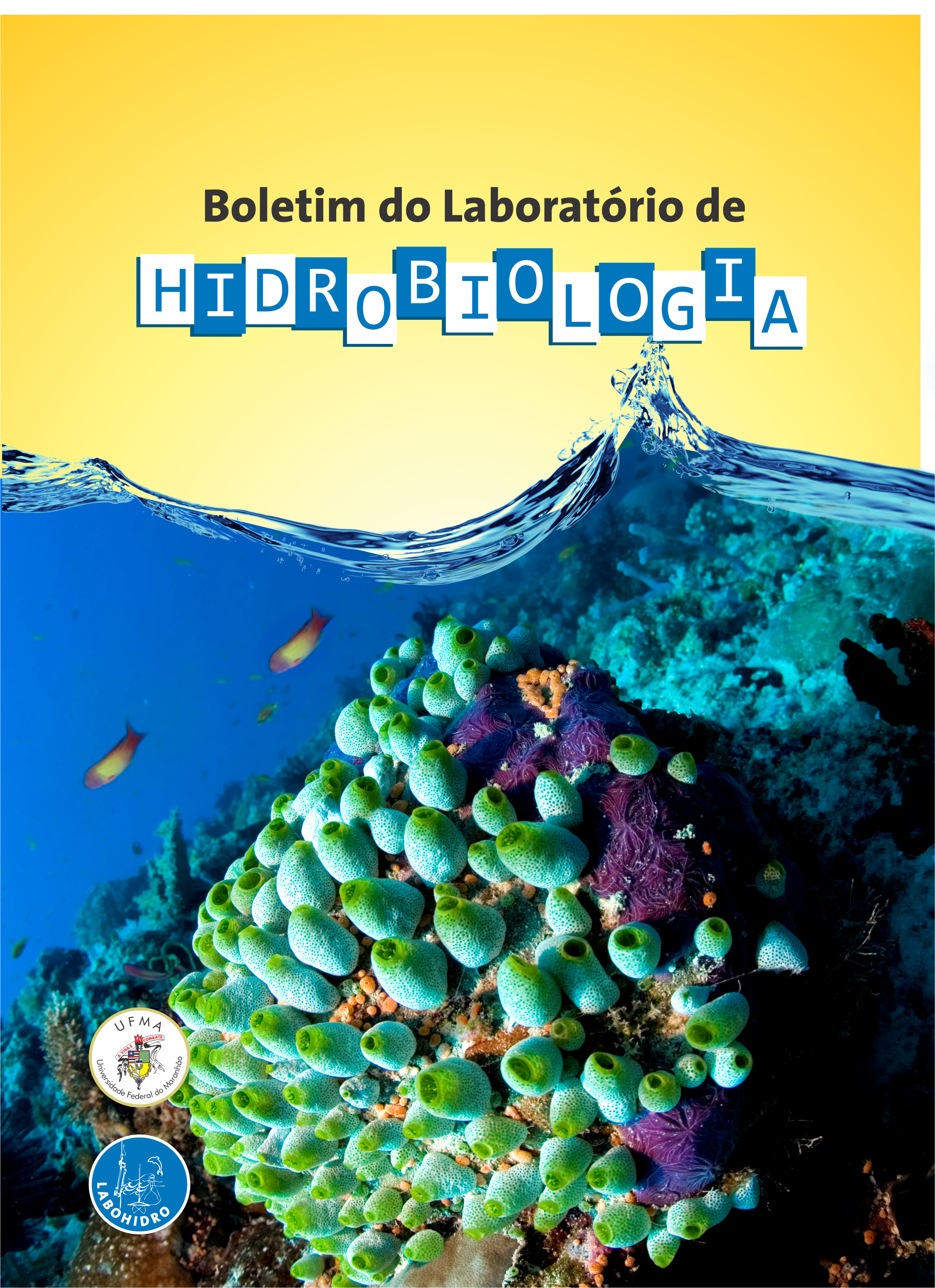PHYTOPLANKTONIC COMMUNITY IN ANTHROPITED AREA IN THE ANIL RIVER ESTUARY, SÃO LUÍS - MA
DOI:
https://doi.org/10.18764/1981-6421e2023.11Keywords:
Diatoms, Phytoplankton, MicroalgaeAbstract
Estuaries, as they are connecting areas between rivers and seas, favor the development of urban agglomerations and, as a result, enable activities with great socioeconomic impact, in addition to supporting intense biological activity, being authentic nurseries and maternity hospitals. To carry out this work, two sampling campaigns were carried out, corresponding to the rainy season – PC (Apr/2022) and the dry season – PE (Sep/2022), in spring tides,
during the ebb tide. Collections took place at two sampling points, located upstream of the river, therefore, with greater limnetic input. The studied area corresponds to the Anil River estuary – ERA, currently the most urbanized estuary on the island of São Luís, MA. The physical-chemical data and nutrients of the seawater and the qualitative analysis of the phytoplankton were evaluated, packaged in bottles and transported to the Laboratory of Plant and Marine Biology (LBVM/UEMA) and kept in a freezer. Then, the phytoplankton species were identified to the lowest possible taxonomic level with the aid of an optical microscope and identification keys. For the relevant results, the reduction in water
transparency and salinity values during the rainy season occurred due to a greater supply of water received by estuaries and high rainfall. For nutrients, ammonium ion showed high concentrations at both sampling points, which may be a result of the continuous release of sewage in the study area. In ERA, 156 phytoplankton taxa were recorded, there
was a predominance of diatoms, which were the group with the largest number of families and species throughout the study, they are considered the most important and common phytoplankton group in coastal and estuarine areas.
Downloads
References
APHA; AWWA; WEF. Standard Methods for the examination of water and wastewater. 22nd ed. Washington, 1496p. 2012.
ALCÂNTARA, E. H.; AMORIM, A. J. E. Análise morfométrica de uma bacia hidrográfica costeira: um estudo de caso. Caminhos de Geografia, 7 (14), p. 70-77, 2005.
ALCÂNTARA, E. H.; MOCHEL, F. R.; AMORIM, A. J. E.; THEVAND, A. Modelagem da profundida de Secchi e da concentração de clorofila a no estuário do rio Anil, São Luís - MA. Caminhos de Geografia, 2 (13), p. 19-40, 2004.
BAZIN, P.; JOUENNE, F.; DETON-CABANILLAS, A. F.; PÉREZ-RUZAFA, Á.; VÉRON, B. Complex patterns inphytoplankton and microeukaryot e diversity along the estuarine continuum. Hydrobiologia, v. 726, p. 155-178, 2014.CAVALCANTI, L. F.; CUTRIM, M. V. J; LOURENÇO, C. B.; SANTOS-SÁ, A. K. D.; OLIVEIRA, A. L. L.;AZEVEDO-CUTRIM A. C. G. Patterns of phytoplankton structure in response to environmental gradients in a macrotidalestuary of the Equatorial Margin (Atlantic coast Brasil). Estuarine, Coastal and shelf Science,v. 245, 2020.
CLOERN, J. E. Our evolving conceptual model of the coastal eutrophication problem. Marine EcologyProgressSeries,210, p. 223-253, 2001.
CRUZ, W. L.; RIBEIRO, D. Q.; PEREIRA, E. D. Conflitos de Uso e Ocupação em Áreas dePreservação Permanente naBacia do Rio Anil-São Luís, MA. Revista Geonorte, v. 11, n. 37, p. 229-247, 2020.
DUARTE-DOS-SANTOS, A. K.; CUTRIM, M. V. J.; FERREIRA, F. S.; LUVIZOTTO SANTOS, R.; AZEVEDO-CUTRIM, A.C. G.; ARAÚJO, B. O.; OLIVEIRA, A. L. L.; FURTADO, J. A.; DINIZ, S. C. D. Índice de proteção da vida aquática de uma bacia urbana do rio Bacanga no norte do Brasil, São Luís - MA. Revista Brasileira de Biologia, 77 (3), p.602-615, 2017.
EFFENDI, H.; KAWAROEB, M.; LESTARIA, D F.; MURSALINA, P. T. Distribuição da diversidade e abundância de fitoplâncton no Delta de Mahakam, Kalimantan Oriental. Proc. Environ. Sci., 33, p. 496-504, 2016.
ESKINAZI-LEÇA, E.; KOENING, M. L.; SILVA-CUNHA, M. G. G. Estrutura e dinâmica da comunidade fitoplanctônica. In: ESKINAZI-LEÇA, E.; LEITÃO, S. N.; COSTA, M. F. Oceanografia: um Cenário Tropical. Recife: EdiçõesBagaço, p. 353-373, 2004.
FLÖDER, S.; BURNS, C. W. The influence of fluctuating light on diversity and species number of nutriente-limited phytoplankton. Journal of Phycology, v. 41, n. 5, p. 950-956,2005.
GREGO, C. K. S.; FEITOSA, F. A. N.; HONORATO DA SILVA, M.; FLORES-MONTES, M. J. Distribuição espacial esazonal da clorofila a fitoplanctônica e hidrologia do estuário do rio Timbó (Paulista-PE). Tropical Oceanography, v. 32,p. 181-199, Recife, 2004.
GUIRY, M. D.; GUIRY, G. M. AlgaeBase: World-wide eletronic publication,National University of Ireland, Galway.2022. Disponível em: http://www.algabase.org.
HUANG, L.; JIAN, W.; SONG, X.; HUANG, X.; LIU, S.; QIAN, P.; YIN, K.; WU, M. Species diversity and distribuition forphytoplankton of the Pearl River estuary during rainy and dry seasons. Marine Pollution Bulletin, v. 49, n. 7-8, p.588-596, 2004.
NEVES, R., CHOZAS, S., COSTA, L. T.; RUFINO, R. Reserva Natural do Estuário da Sado, uma contribuição para o plano de gestão. Instituto da Conservação da Natureza/Centro de Zonas Húmidas, pp. 70, 2004.
PAERL, H. W.; TUCKER, C. S. Ecologyof blue-greenalgae in aquacultureponds. Journal of the World Aquaculture Society, v. 26, n. 2, p. 109-131, 1995.
RODRIGUES, E. I.; CUTRIM, M. V. J. Relações entre as variáveis físicas, químicas e fitoplanctônicas de três áreas estuarinas da costa Norte do Brasil - São José de Ribamar, Cedral e Cajapió, Estado do Maranhão. Arquivos de Ciências do Mar, v. 43, n. 2, p. 45-54, 2010.
SANTOS, T. T. L.; MARINS, R. V.; DIAS, F. J. da S. Carbon influenceon metal distributioninsediment of Amazonian macrotidal estuaries of northeastern Brazil. Environmental Monitoringand Assessment, p. 1-16, 2019.
SANTOS, T. T. L.; SEREJO, J. H. F.; LIMA, H. P.; ESCHRIQUE, S. A. Dissolved Nutrient Fluxes in Macrotidal Estuary in the Amazonian Region, Brazil. Tropical Oceanography, v. 48, n. 1, p. 1–19, 2020.
SILVA, G. S.; SANTOS, E. A.; CORRÊA, L. B.; MARQUES, A. L. B.; MARQUES, E. P.; SOUSA, E. R.; SILVA, G. S. Avaliação integrada da qualidade de águas aquáticas: grau de trofia e proteção da vida aquática nos rios Anil e Bacanga, São Luís (MA). Engenharia Sanitária e Ambiental, 19 (3), p. 245-250, 2014.
Downloads
Published
How to Cite
Issue
Section
License
Copyright (c) 2024 Boletim do Laboratório de Hidrobiologia

This work is licensed under a Creative Commons Attribution 4.0 International License.





